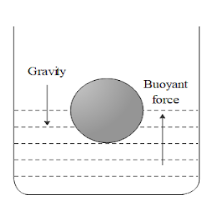
The upward force acting on the body immersed in a fluid is called:
(A) Equilibrium force
(B) Buoyant force
(C) True weight
(D) Net force
Answer
460.8k+ views
Hint
When we immerse a body in any fluid, we can feel an upward push in the body. That force makes the body less in weight in the fluid and makes it float. This force is best explained in Archimedes principle also.
Complete step by step answer
Let us consider a body, immersed in a beaker containing water. The force of gravity acts downwards whereas, there is also a force that acts upward. The upward force that acts on the body is called as Buoyant force and the phenomenon is called as Buoyancy.

As we know, the pressure in a fluid column increases with depth. Hence, the pressure at the bottom of an object immersed in the fluid is greater than that at the top. The difference in this pressure results in a net upward force on the object which we define as buoyant force.
Now, to determine the buoyant force, we need to find the forces acting on the body as a whole.
Let, the downward force acting on it be Bottom and the upward force acting on it be Ftop.
Then, the buoyant force ${F_b} = {F_{bottom}} + {F_{top}}$
We know that pressure is equal to force acting per unit area.
⇒$P = \dfrac{F}{A}$
So, the force becomes,
$F = PA$
Then, the buoyant force becomes,
${F_b} = {F_{bottom}}A - {F_{top}}A$
As we know that$P = \rho gh$
⇒${F_b} = (\rho g{h_{bottom}})A - (\rho g{h_{top}})A$
⇒${F_b} = \rho gA({h_{bottom}} - {h_{top}})$
Thus, we have seen that the downward force acting on the body is called a buoyant force.
Hence, the correct answer is option B.
Note
We see that the net force on the body is theoretically equal to the buoyant force as the body floats in the water and does not sink. This phenomenon, buoyancy, is applied in various areas like ships, submarines, hot air balloons etc.
When we immerse a body in any fluid, we can feel an upward push in the body. That force makes the body less in weight in the fluid and makes it float. This force is best explained in Archimedes principle also.
Complete step by step answer
Let us consider a body, immersed in a beaker containing water. The force of gravity acts downwards whereas, there is also a force that acts upward. The upward force that acts on the body is called as Buoyant force and the phenomenon is called as Buoyancy.

As we know, the pressure in a fluid column increases with depth. Hence, the pressure at the bottom of an object immersed in the fluid is greater than that at the top. The difference in this pressure results in a net upward force on the object which we define as buoyant force.
Now, to determine the buoyant force, we need to find the forces acting on the body as a whole.
Let, the downward force acting on it be Bottom and the upward force acting on it be Ftop.
Then, the buoyant force ${F_b} = {F_{bottom}} + {F_{top}}$
We know that pressure is equal to force acting per unit area.
⇒$P = \dfrac{F}{A}$
So, the force becomes,
$F = PA$
Then, the buoyant force becomes,
${F_b} = {F_{bottom}}A - {F_{top}}A$
As we know that$P = \rho gh$
⇒${F_b} = (\rho g{h_{bottom}})A - (\rho g{h_{top}})A$
⇒${F_b} = \rho gA({h_{bottom}} - {h_{top}})$
Thus, we have seen that the downward force acting on the body is called a buoyant force.
Hence, the correct answer is option B.
Note
We see that the net force on the body is theoretically equal to the buoyant force as the body floats in the water and does not sink. This phenomenon, buoyancy, is applied in various areas like ships, submarines, hot air balloons etc.
Recently Updated Pages
Master Class 11 Accountancy: Engaging Questions & Answers for Success

Glucose when reduced with HI and red Phosphorus gives class 11 chemistry CBSE

The highest possible oxidation states of Uranium and class 11 chemistry CBSE

Find the value of x if the mode of the following data class 11 maths CBSE

Which of the following can be used in the Friedel Crafts class 11 chemistry CBSE

A sphere of mass 40 kg is attracted by a second sphere class 11 physics CBSE

Trending doubts
10 examples of friction in our daily life

One Metric ton is equal to kg A 10000 B 1000 C 100 class 11 physics CBSE

Difference Between Prokaryotic Cells and Eukaryotic Cells

State and prove Bernoullis theorem class 11 physics CBSE

What organs are located on the left side of your body class 11 biology CBSE

How many valence electrons does nitrogen have class 11 chemistry CBSE




